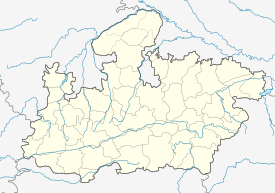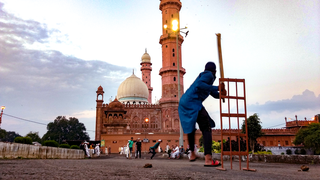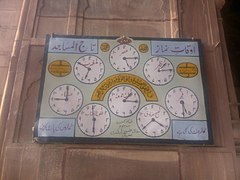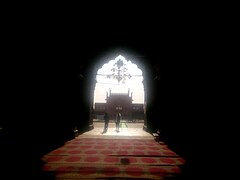Taj-ul-Masajid
| Taj-ul-Masajid | |
|---|---|
تَاجُ ٱلْمَسَاجِد | |
| Religion | |
| Affiliation | Sunni Islam |
| Location | |
| Location | Bhopal, Madhya Pradesh, India |
| Geographic coordinates | 23°15′47″N 77°23′34″E / 23.262934°N 77.392802°ECoordinates: 23°15′47″N 77°23′34″E / 23.262934°N 77.392802°E |
| Architecture | |
| Type | Mosque |
| Style | Indo-Islamic architecture, Mughal architecture |
| Funded by | Nawab Shah Jahan Begum, Sultan Jahan Begum |
| Capacity | 175,000+ |
| Interior area | 23,000 m2 (250,000 sq ft)[1] |
| Dome(s) | 3 |
| Minaret(s) | 2 |
| Minaret height | 67 m |
| Part of a series on |
| Deobandism |
|---|
| File:Darul Uloom Deoband Logo.svg |
| Ideology and influences |
| Founders and key figures |
|
| Notable institutions |
| Centres (markaz) of Tablighi Jamaat |
| Associated organizations |
The Taj-ul-Masajid (Arabic: تَاجُ ٱلْمَسَاجِد, romanized: Tāj-ul-Masājid, lit. 'Crown of Mosques') or Tāj-ul-Masjid (), is a mosque situated in Bhopal, Madhya Pradesh, India.[2] It is the largest mosque in India and one of the largest mosques in Asia.[1][3]
History[edit]
The construction of the Taj-ul-Masajid was started by Nawab Shah Jahan Begum of Bhopal, in the newly-built walled suburb of Shahjahanabad. The exact year construction was started is unclear; Sharma estimates it to be 1871. After Shah Jahan Begum died in 1901, the mosque continued to be built by her daughter Sultan Jahan Begum, till the end of her lifetime. The structure was planned in the midst of three water bodies, namely: Munshi Hussain Talab; Noor Mahal Talab; and Motia Talab.[citation needed]
The mosque was not completed due to a lack of funds, and construction did not resume until 1971. The entrance was renovated with motifs from 13th century Syrian mosques donated by the Emir of Kuwait in memory of his late wife.[4]
During the COVID-19 pandemic, the mosque was used as a vaccination centre.[5]
Architecture[edit]
The Taj-ul-Masajid largely takes inspiration from Mughal architecture.[citation needed] The mosque has a pink facade topped by two 18-storey high octagonal minarets with marble domes, an impressive main hallway with attractive pillars, and marble flooring resembling the likes of Jama Masjid in Delhi and the Badshahi Mosque of Lahore.[6] It has a courtyard with a large ablution tank in the centre. It has a double-storeyed gateway with four recessed archways and nine cusped multifold openings in the main prayer hall. The massive pillars in the hall hold 27 ceilings through squinted arches of which 16 ceilings are decorated with ornate petalled designs.[citation needed]
The mosque also features a zenana (women's gallery), rare given that prayer from home was the norm for women at the time of the mosque's construction.[citation needed]
Annual congregation[edit]
The Bhopal Tablighi Ijtema is an annual three-day congregation that draws people from all over the world. It was held at Taj-ul-Masajid until it was shifted to Islam Nagar outside the city due to shortage of space.[citation needed]
Gallery[edit]
References[edit]
- ↑ 1.0 1.1 McCrohan, Daniel (2010). "The search for the world's smallest mosque". Lonely Planet.
- ↑ "Wondrous Masajid". Deccan Herald. 16 March 2013. Retrieved 26 June 2021.
- ↑ "Taj-ul-Masajid". bhopal.nic.in. Retrieved 27 September 2014.
{{cite web}}: CS1 maint: url-status (link) - ↑ Mulchandani, Anil. "Taj ul Masajid". Times of India Travel. Retrieved 26 June 2021.
{{cite web}}: CS1 maint: url-status (link) - ↑ "Historical Taj-ul-Masajid premises in Bhopal used to vaccinate inter-faith people". The Siasat Daily. 10 April 2021. Retrieved 26 June 2021.
- ↑ "Magnificent, and elaborate". The Hindu. 25 September 2015. ISSN 0971-751X. Retrieved 26 June 2021.
- Pages using Lang-xx templates
- Articles with unsourced statements from June 2021
- Articles with unsourced statements from November 2019
- Tourist attractions in Bhopal
- Mosques in Madhya Pradesh
- Mosques completed in 1985
- Buildings and structures in Bhopal
- 20th-century mosques
- 1985 establishments in Madhya Pradesh












